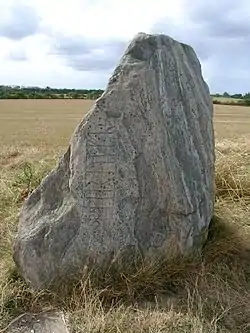Hærulf Runestone
The Hærulf Runestone is a Viking Age runestone located north of Hovslund's station in Southern Jutland, Denmark.
| Hærulf Runestone | |
|---|---|
 | |
| Height | 124 cm |
| Width | 24-59 cm |
| Writing | Younger Futhark |
| Created | c. 10th century |
| Discovered | 1592 Immervad, Jutland, Denmark |
| Present location | Jutland, Denmark |
| Culture | Norse |
| Rundata ID | DR 15 |
| Style | RAK |
| Runemaster | Unknown |
| Text – Native | |
| Old Norse : Hærulfr | |
| Translation | |
| Hærulf | |
Description
The Hærulf Runestone dates from the 10th century and is classified as being carved in runestone style RAK. This is the classification for inscriptions with runic bands that have straight ends without any attached serpent or beast heads. The stone was originally located at Øster Løgum[1] near the north-south Jutland highway. It is notable not only for its short inscription,[2] which is the name Hærulf, but for having been taken to Berlin as war booty in 1864. It was not until 1952 that the stone was returned to Denmark near to its original location. Although the inscription only has a single word, a single dot, which is normally a punctuation mark used as a word divider, has been placed before and after the runes hairulfʀ for the name Hærulf.[3] This name is a shortened form of the Proto-Norse name Hariwulfa or Hariwulfʀ, which means either "Warrior-Wolf" or "War Host-Wolf," that is attested to on the Istaby and Stentoften Runestones.[4][5]
The stone is known locally as the Hærulfstenen.
Inscription
Transliteration of the runes into Latin characters
- ' hairulfʀ ' [1]
References
- Project Samnordisk Runtextdatabas Svensk - Rundata entry for DR 15.
- Christiansen, Eric (2006). The Norsemen in the Viking Age. Wiley-Blackwell. p. 13. ISBN 978-0-631-21677-3.
- Meijer-Zwolle, Jan (2002). "Runic Terminology". In Vennemann, Theo (ed.). Amsterdamer Beiträge zur älteren Germaninstik. Amsterdam: Rodopi. p. 51. ISBN 90-420-1579-9.
- Sundqvist, Olof; Hultgård, Anders (2004). "The Lycophoric Names of the 6th to 7th Century Blekinge Runestones and the Problem of Their Ideological Background". In van Nahl, Astrid; Elmevik, Lennart et seq (eds.). Namenwelten: Orts- und Personennamen in Historischer Sicht. Berlin: Walter de Gruyter. pp. 583–602. ISBN 3-11-018108-8. p. 584-85.
- Looijenga, Tineke (2003). Texts & Contexts of the Oldest Runic Inscriptions. Leiden: Koninklijke Brill NV. p. 181. ISBN 90-04-12396-2.